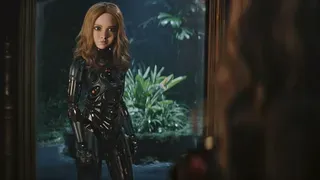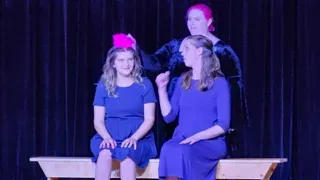October 3, 2014
Annabelle
Jake Mulligan READ TIME: 4 MIN.
In early August, 1969, the actress Sharon Tate (wife of Roman Polanski), four of her friends, and her unborn child were ruthlessly murdered, in an excessively showy fashion, by member of Charles Manson's "family." Finally, 45 years later, we can crassly wring the bloodstains out of the furniture and recycle them for Hollywood entertainment. (I say this as if that hasn't been done already.)
"Annabelle" is ostensibly a prequel to "The Conjuring," but more so, it's an amalgam of disparate elements that surrounded the Tate murders: the involvement of the Family, the tragic iconography that accompanies a pretty blonde pregnant white girl being the subject of violence, the work of Polanski himself. It's all trotted out here by Gary Daubner's script. The myths surrounding the killings used to produce cheap scares and ready-made atmosphere; instant shortcuts to a theoretically loaded death-of-the-60s-setting.
"It's a different world out there," Mia Gordon (Annabelle Wallis), notes while watching footage of a faux-Manson-Family on her antiquated television. She's sporting Tate's haircut, and looks about 9 months pregnant, much as Tate was. Her halfway-absentee husband brings her home a childhood doll she once lost -- the Annabelle of the title, previously featured in "The Conjuring" -- to win himself some brownie points. That backfires when the fake Manson'ers break into their home, commit suicide, and bleed all over the doll -- which imbues it (of course) with the spirit of a dark lord who will haunt them until it consumes their souls. Despite the help of a local paranormal expert (an entirely wasted Alfre Woodard, playing the black-person-who-only-exists-to-help-her-white-friends), the demon follows them from home to home: Mia throws Annabelle in the trash, and she's back on the shelf the next day.
The film's mostly-unspoken conceit is that Mia is only horrified by the demon when she's separated from her husband (Ward Horton), which should feel a bit retrograde -- but really, it's an excuse for isolated scare-bait set pieces more than it is old-school sexism. "Annabelle" revels in leaving us alone with Mia, terrified as she is as to her fate: The scariest sequence leaves her in an abandoned elevator that refuses to move, its doors opening to reveal the same basement over and over, leaving her -- and us -- alone to wonder which time the open door will be accompanied by a jump scare. At another point, she's menaced -- literally -- by her home life: The oven, the television, her sewing machine; they all turn against her in time. Give "Annabelle" credit for one thing: Its scares are tied, inextricably, to a very real form of housewife anxiety.
The film is directed by John Leonetti, who proved his visual chops serving as the cinematographer on the legitimately underrated giallo-tribute "I Know Who Killed Me." The images in "Annabelle" skew in a different direction, though, far removed from the blistering reds and blues of that Lohan picture. The colors here are halfway lifeless, as if aiming to replicate the drained palette and beige shadings of faded home video footage. Leonetti's focus here, though, is not in the colors, but in the use of space: He's constantly splitting our focus between two or three points in the wide frame, forcing us to dart our eyes from one point to the other constantly, trying to anticipate wherever the next scare may come from. The aforementioned scene with the elevator works so well because we never know where to look: Do we stare at Mia, cowered in the left of the frame; at the door, slowly opening on the right; or at the shadow-shrouded corner on the right hand side?
Leonetti also takes a couple opportunities to put together bravura long takes. During the initial break-in by the faux-Manson-Family, his camera sticks with Mia for the entirety; tracking back and forth from her house to the neighbors and then back inside her own home, all in a single unbroken shot. Throughout the whole of the shot, he's setting up scares� little demons, quiet Satanists -- in the backgrounds of the frames that Mia is running through. (More smart use of the wide-scope frame.) It's intellectually slight but cinematically invigorating, and no less an eye-catcher than the already-famous long take that anchored an episode of "True Detective" earlier this year.
Simply put, this director knows where to steal from: A creepy archival-footage sequence is lifted direct from "Texas Chainsaw," a series of menacing zooms into ostensibly-normal neighborhood conversations is "borrowed" from Carpenter's original "Halloween," some crash zooms are taken from the films of Sam Raimi. There's even a shot that takes us into a cup of coffee and then out into a different scene, which is lifted directly from Lynch. That's not even to mention Polanski's twin masterpieces, "Repulsion" and "Rosemary's Baby," tales of young women asphyxiated by loneliness and by family, respectively... Their influence hangs over this film, specters in their own right.
The nods don't add up to much, but they give the movie a throwback-to-the-classics flavor; it's a bit like watching a mediocre local band cover the classics. Leonetti seems to be having enough fun that, after a while, your trepidations regarding the use of the Tate murders and the retrograde gender roles seem to dissipate. This is indeed a badly acted and ludicrously plotted movie that indulges problematic black savior archetypes and even more problematic Manson/Tate-related allusions, all while stealing wholesale from much better movies, but there's an admirable-if-not-idiosyncratic directorial vision carrying us through all that mediocre pap, making the garbage a slight bit more palatable. Polanski was a master chef, of course, and "Annabelle" and Leonetti are but the products of a fast food joint. But as cheesy meals go, you could do much worse.





